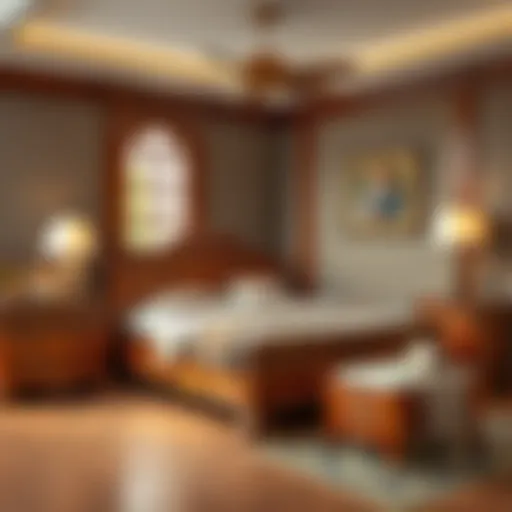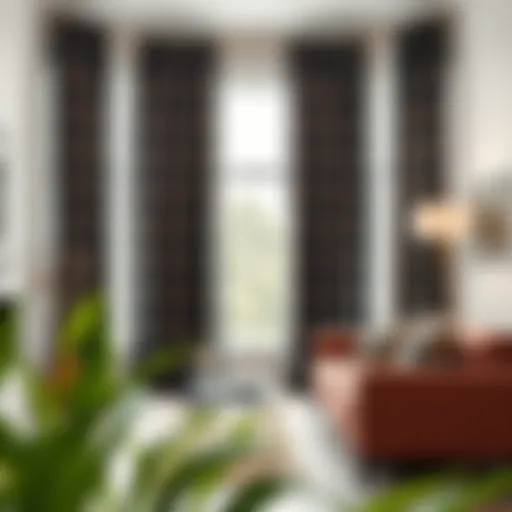Exploring Stylish Sanctuary Window Panels for Your Home

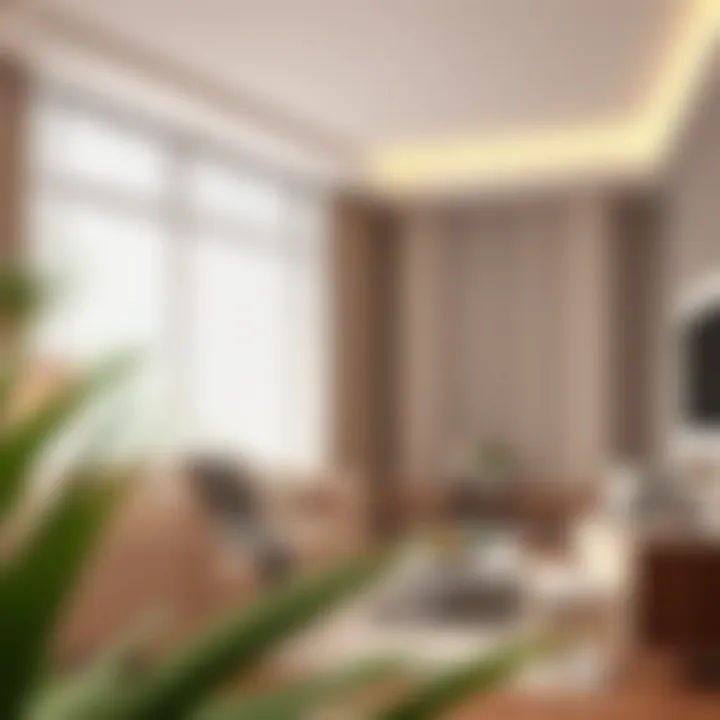
Intro
In the world of home decor, window treatments often take a backseat to larger items like furniture or artwork. However, as they can significantly influence the ambiance of a room, they deserve the spotlight too. This article will explore the multifaceted aspects of style sanctuary window panels, shedding light on their crucial role in transforming living spaces.
As we delve deeper, we’ll examine the various materials available for these panels, each lending its character and charm to your home. Additionally, we’ll analyze design principles that not only enhance aesthetic appeal but also improve functionality. With careful consideration of how natural light interacts with interior spaces, we will provide you with insights on selecting the perfect paneling that brings harmony to your environment. Expect a wealth of practical advice tailored for designers, retailers, homeowners, and DIY enthusiasts aiming to elevate their surroundings.
To better appreciate the significance of window panels in interiors, it’s vital to understand how they resonate with personal style and the overall design scheme of a room. From classic looks that evoke a sense of timelessness to modern styles that embrace simplicity, style sanctuary window panels can harmonize diverse aesthetics, making them an essential part of any decor plan.
Keywords
- Window treatments
- Home decor
- Interior design
- Light control
- Panel fabrics
Stay with us as we embark on this journey to uncover the transformative power of style sanctuary window panels, ensuring your choices reflect not only functionality but also your unique taste.
Prelims to Style Sanctuary
In the realm of home decor, every decision carries weight, but few are as pivotal as those regarding window treatments. They serve not only a functional purpose but also greatly influence the aesthetic harmony of a room. This is where the concept of a style sanctuary emerges, acting as a guiding principle for both designers and homeowners alike. By establishing a style sanctuary, one creates an oasis that reflects personal taste and enhances comfort.
A style sanctuary revolves around selecting elements that resonate with a homeowner’s ethos while ensuring that practicality does not get sidelined. Think of it as curating a space that feels both inviting and harmonious, where form meets function. Herein lies the essence of style sanctuary window panels.
From rich drapery that adds warmth to a minimalist Roman shade that offers contemporary flair, the choices are vast. Important considerations include how these selections integrate with color schemes, the natural light available, and the overall functionality desired. When one opts for window treatments, it’s akin to dressing the windows of your home; a reflection of your personality emerges not just through paint colors or furniture styles but also through the panels chosen.
Moreover, what you dress your windows with throws light on your lifestyle and preferences. For example, heavy blackout panels may imply a need for solitude and relaxation, while bright sheer panels may suggest a longing for openness and connection to the outside world. Thus, understanding the significance of the style sanctuary sets the stage for forging not just an interior, but a lived experience that feels uniquely your own.
"The windows are the eyes of the house. They are the first impression that speaks volumes about the dwelling within."
As we delve deeper into this exploration, we shall unpack the diverse types of window panels available, their materials, design principles, and installational insights. This journey addresses the significance of window treatments in the broader context of interior design, assisting readers in navigating the choices that lead to a sanctuary reflected in their living space.
Types of Window Panels
When designing a space, one can hardly overlook the significance of window treatments, particularly window panels. They do more than merely block out light or provide privacy; they serve as an integral component of a room's overall aesthetics. Choosing the right type of panel can transform a mundane room into a breathtaking sanctuary. Here, we explore the various types of window panels, focusing on their specific characteristics and advantages that cater to different sensibilities and needs.
Drapery Panels
Drapery panels are perhaps the most traditional choice of window treatments. Often made from richly textured fabrics, these panels can achieve a sense of elegance that other types might lack. Their versatility allows for a range of styles from classic to contemporary. One distinctive feature of drapery panels is their ability to add layers and depth to a window, creating a focal point in any room.
- Benefits:
- Insulation: Drapery can help insulate a room, keeping it cooler in summer and warmer during winter.
- Varied Fabrics: There’s a wealth of fabric choices available, from luxurious silk to durable cotton, providing options for every budget.
- Customization: Many drapery panels can be tailored to fit specific window measurements, ensuring a perfect fit.
While they are undeniably beautiful, it’s essential to consider maintenance. Fabrics can fade, and dust can settle in the folds, necessitating regular cleaning.
Roman Shades
Roman shades have gained a loyal following among designers and homeowners alike. They are characterized by their clean lines and the way they stack neatly when drawn up. Available in a myriad of fabrics and colors, these shades can bridge the gap between functionality and style.
- Benefits:
- Space Saving: Perfect for smaller rooms since they don’t require much space to operate.
- Light Control: Adjustable in a way that allows for precise light control, making them suitable for tasks that require focus.
- Contemporary Look: Their minimalistic style complements modern design aesthetics very well.
However, as with any design choice, it’s crucial to consider the fabric choice, particularly in areas with high humidity, where some materials may not fare well.
Sheer Panels
Sheer panels present another fascinating option for window treatments. They are elegant, subtle, and perfect for creating a soft ambiance. Often used in conjunction with heavier fabrics, sheer panels filter sunlight, creating a warm glow in the interiors.
- Benefits:
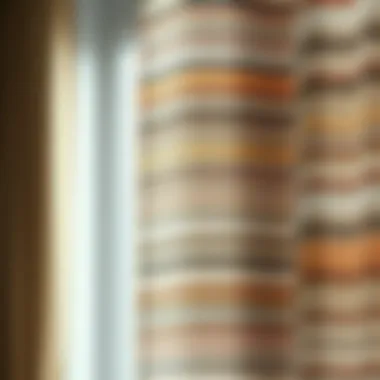
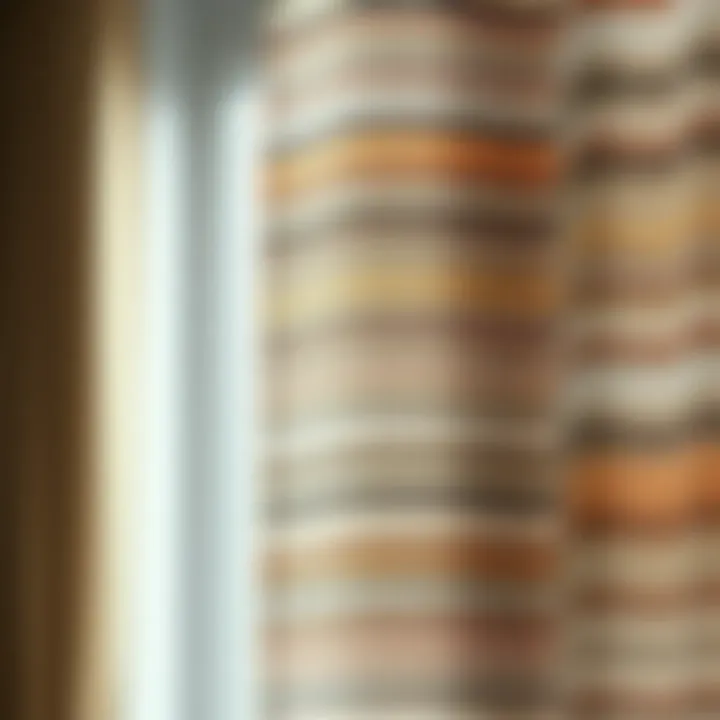
- Soft Light: They allow natural light to permeate the space without the harshness of direct sunlight.
- Easy Pairing: Their subtle design means they can complement almost any style of décor.
- Airy Feel: Create an open and airy atmosphere that suits spaces in coastal or contemporary designs.
Nevertheless, sheer panels might not be suitable for those who desire complete privacy. Blending them with other panel types can mitigate this limitation.
Blackout Panels
For those looking to create a cozy haven, especially for bedrooms or media rooms, blackout panels are a game-changer. These panels are crafted with special materials that can block all light, ensuring optimal darkness. They are increasingly being recognized as an essential element in enhancing sleep quality.
- Benefits:
- Light Control: Ideal for spaces where light must be minimized completely.
- Energy Efficiency: Can also contribute to better energy efficiency by keeping heat from entering your space in summer and retaining warmth during winter.
- Noise Reduction: Many blackout panels also have sound absorption qualities, making them great for busy urban settings.
However, it's worth keeping in mind that blackout panels may require extra care in terms of cleaning, as heavier materials can collect dust more easily.
Ultimately, understanding the unique features and functionalities of each window panel type aids in making well-informed decisions that align with both aesthetic preferences and practical needs.
Through careful consideration of these options, one can achieve that much-desired sanctuary feel in their home, making it a true reflection of personal style and comfort.
Materials Used in Window Panels
When it comes to style sanctuary window panels, the choice of material plays a pivotal role in shaping the overall aesthetic and functionality of a space. Not only do different materials affect the look and feel of a room, but they also influence aspects like light control, insulation, and maintenance needs. Selecting the appropriate material ensures that the window panels blend seamlessly with the room's decor while serving their specific purposes. The variety of materials available today provides numerous options for homeowners and designers alike, allowing for personalization and creativity in interior spaces.
Fabric Choices
Fabric options can dramatically alter the ambiance of a room, setting the tone for comfort and style. Traditionally, fabrics are categorized into three main types: natural, synthetic, and blended. Each has unique properties that can resonate with different design preferences and practical needs.
Natural Fabrics
Natural fabrics, such as cotton, linen, and silk, have an innate charm that adds warmth and elegance to window panels. One key characteristic of natural fabrics is their breathability, which allows for a comfortable airflow, helping to regulate the temperature of a room. They are often favored for their luxurious feel as they drape beautifully, giving a soft, organic look to the decor.
However, natural fabrics come with their own set of challenges. They can be more susceptible to fading and wear over time when exposed to sunlight, which makes them a less durable option in high sunlight areas. Additionally, cleaning natural fabrics often requires more delicate handling, as harsh chemicals can damage their fibers.
Synthetic Fabrics
On the flip side, synthetic fabrics like polyester and nylon offer significant advantages in terms of durability and maintenance. These materials are known for their strong resistance to stains and fading, making them a practical choice for window panels in busy households. They often come in a wider range of colors and patterns than their natural counterparts, providing flexibility in design.
Synthetic fabrics tend to be less breathable, which could trap heat and moisture. This means that while they might stand the test of time decor-wise, they could potentially lead to discomfort in warmer climates. Thus, balancing aesthetic appeal with comfort is essential when opting for these materials.
Blend Options
Blend options, which combine natural and synthetic fibers, are gaining popularity for their balanced benefits. These fabrics can marry the softness and aesthetic appeal of natural textiles with the durability of synthetic materials. For example, a cotton-polyester blend might have the smooth feel of cotton while maintaining the longevity and easy-care properties of polyester.
Homeowners often choose blends for their versatility. They can achieve a soft, inviting look without sacrificing practicality. However, one should be aware that not all blend fabrics are created equal, as the ratio of fibers can affect the final product's texture and performance. It's wise to consider what specific use the window panel will have and how much wear and tear it is likely to face.
Wood and Faux Wood
Wood has always been a go-to choice for window panels due to its classic appeal and ability to add a touch of elegance. Real wood panels can be stained or painted to match any decor, while their structural integrity provides a durable option. However, they can warp or fade if exposed to excessive moisture or direct sunlight, requiring careful monitoring.
Faux wood, on the other hand, offers the same visual appeal without some of the drawbacks. Made from materials like PVC, these can mimic the look of real wood but are much more resistant to moisture and fading. This makes faux wood an ideal candidate for areas like kitchens or bathrooms where humidity is an issue. In terms of maintaining a cohesive design, both wood and faux wood can serve as excellent foundations for stylish window coverings, making sure they stand tall against time and fashion.
Metal and Vinyl Options
Metal and vinyl panels offer a more contemporary revamp to traditional window treatments. Metal panels can deliver a sleek, industrial look, especially favored in modern or minimalist designs. They are incredibly durable and can withstand harsh weather conditions making them suitable for both indoor and outdoor use. However, they may lack the warmth of fabric and wood.
Vinyl options, available in a myriad of colors and textures, can also mimic various materials while being incredibly easy on the wallet. These panels are perfect for those on a budget, providing a cost-effective solution without sacrificing style. A significant downside, though, is that vinyl might not provide the insulation of other materials, potentially allowing for temperature fluctuations. Thus, understanding the insulation properties of window treatment is crucial when designing a space.
Design Principles for Window Panels
Understanding the importance of design principles for window panels is crucial in creating a cohesive and stylish environment. Window panels can influence not only the aesthetics of a room but also its overall vibe. Thoughtful design choices reflect personal taste while considering functionality, making them essential in interior design. Choosing the right elements such as color, pattern, texture, and scale can transform a simple living space into a personal style sanctuary.
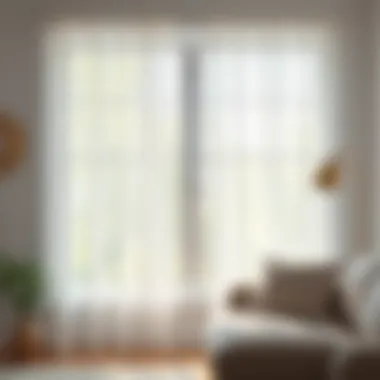
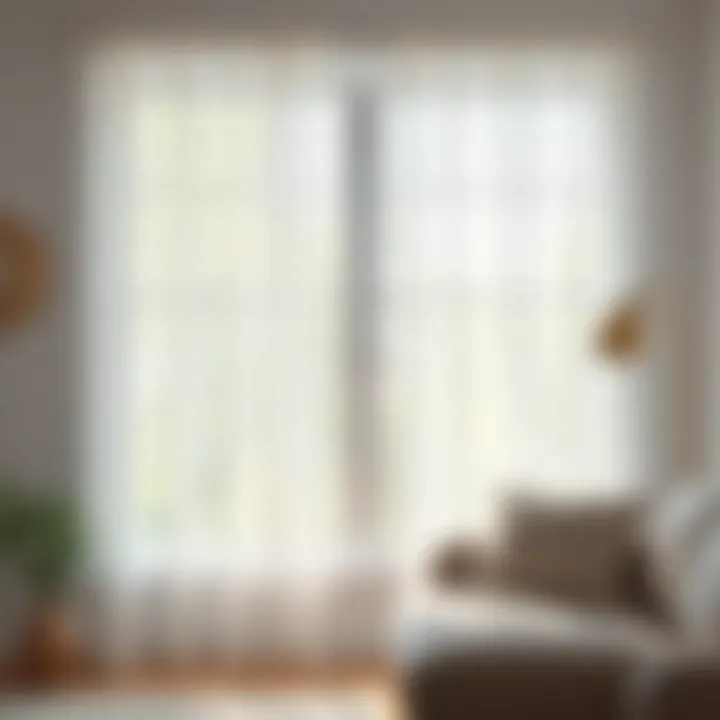
Color Theory in Panel Selection
Color plays a vital role in interior design, serving as a powerful tool that evokes emotions and sets the mood for a space. The selection of hues for window panels requires an understanding of color theory. For instance, colors like soft blues and greens tend to impart a serene atmosphere, ideal for bedrooms or spaces intended for relaxation. In contrast, bolder colors like deep reds or bright yellows can imbue energy and vibrancy, suitable for areas designed for interaction, such as living rooms.
When choosing colors, one should consider the existing palette of the room. Here are a few tips:
- Complementary Colors: These are colors that sit opposite each other on the color wheel. When used together, they create a dynamic contrast, making both stand out.
- Analogous Colors: These are colors that sit next to each other on the wheel, resulting in a harmonious and cohesive look. They work particularly well in spaces aiming for unity.
- Neutral Colors: Shades like beige, grey, and white are timeless and versatile, allowing for more flexibility when it comes to decor.
It’s worth noting that natural light might change how a color appears. One should closely observe how light interacts with the chosen color at different times of the day before making a final decision.
Patterns and Textures
The visual interest added by patterns and textures cannot be overstated. Patterns can add a playful element to window panels, while textures can introduce depth and richness. Selecting the right patterns involves a few considerations:
- Scale: Consider the size of the room when choosing patterns. Large patterns can dominate a small space, while tiny patterns may get lost in larger rooms.
- Mixing Patterns: Successfully combining patterns requires balance. For example, if one opts for a bold striped pattern for window panels, pairing it with a subtle floral could create a well-rounded look without overwhelming.
Textures also play an important role. A smooth, silk-like finish can give an air of elegance, while a rougher, linen texture might lean more casual or rustic. Layering different textures enhances the tactile experience and can make a space feel warmer and more inviting.
"Choosing the right pattern and texture is not just about style; it’s about creating an atmosphere that resonates with the spirit of the space."
Proportion and Scale
Finally, the principles of proportion and scale are paramount when selecting window panels. These principles ensure that the panels not only look good with the windows they frame but also fit harmoniously within the overall room dimensions.
- Height of Panels: For rooms with high ceilings, long drapery panels that stretch from the ceiling to the floor can create an illusion of spaciousness. On the other hand, shorter panels might suit cozy spaces better.
- Width of Panels: The width must also be considered. Panels that are too narrow can look skimpy, while overly wide panels can create a cumbersome feel. Ideally, window panels should extend beyond the window’s edges to create a fuller appearance.
The Role of Natural Light
Natural light plays a significant role in the overall aesthetics and functionality of a space. When we think of interior design, we often focus on colors, furniture, and accessories, neglecting the crucial element that is light. More than just lighting up a room, the availability of natural light can transform a dull space into a vibrant sanctuary. It creates an atmosphere that can influence mood, energy levels, and even the perception of space.
Natural light helps in optimizing the interior experiences by enhancing brightness and warmth. It allows colors to pop and textures to come alive, providing not just illumination but a cozy ambiance. Additionally, natural light helps to create a seamless transition between indoor spaces and the outdoors, fostering a connection with nature that can be incredibly refreshing.
Benefits of Natural Lighting
- Enhanced Mood and Productivity: Exposure to natural light is linked to a more positive mood. It can uplift spirits and increase productivity. Many people find working or relaxing in bright, sunlit spaces much more enjoyable than in artificial lighting.
- Energy Efficiency: Utilizing natural light effectively can reduce the reliance on electrical lighting. This not only saves on utility bills but also contributes positively to the environment.
- Aesthetic Appeal: Natural light accentuates architectural features and highlights decor elements. It helps to create shadows and contrasts that add depth to a space. In rooms with large windows, the interplay of sunlight and panels can create stunning visual effects throughout the day.
- Health Benefits: Sunlight is a natural source of Vitamin D. Living in well-lit spaces encourages better sleep patterns, reduces stress, and can even help in preventing certain illnesses.
Controlling Light with Window Panels
Window panels serve as an essential tool for controlling the quality and quantity of natural light entering a room. Choosing the right type of window treatments can enhance the benefits of natural light while also negating its potential drawbacks. Here are some considerations:
- Light Filtering vs. Blackout: Depending on the purpose of your space, you can select panels that allow natural light to gently filter through while maintaining privacy, or you can opt for blackout panels that completely block out light for media rooms or bedrooms.
- Layering Options: Many designers recommend layering window treatments. Combining sheer panels with heavier drapes creates versatility—allowing you to control light according to the time of day and your activities. This flexibility promotes a comfortable atmosphere while still achieving design goals.
- Material Choices: The fabric used in your window panels also greatly affects light control. Sheer materials can soften sunlight and diffuse it throughout a room, while denser fabrics can absorb light and keep a space darker when needed.
- Positioning and Size: The size and positioning of the panels relative to the windows have a direct effect on light control. Larger panels covering expansive windows can maximize natural light while maintaining visual comfort.
"Utilizing natural light can dramatically change a space—not merely in aesthetics but across functions, fostering moods and promoting well-being."
By effectively managing natural light through window panels, homeowners and designers can curate airy, inviting spaces that resonate with calmness and connectivity to the outside world.
Installation and Maintenance
The journey of transforming your living space with style sanctuary window panels doesn't end with selecting the perfect design; it's equally critical to master the installation and maintenance phases. These aspects could mean the difference between a fantastic look and a frustrating experience. Proper installation ensures that your window panels not only fit well but also function as intended—controlling light, enhancing aesthetics, and preserving privacy.
Moreover, ongoing maintenance helps in prolonging the life of your panels, retaining their visual charm, and ensuring your home remains a cozy sanctuary. Ignoring these elements can lead to a cascading effect of issues, such as inefficient light control or wear and tear that detracts from your interior design vision.
Measuring Your Windows
Before you even think about installing your new window panels, you gotta get the measurements right. This step is absolutely crucial. If your panels are too small, they can make the windows appear awkward, while too-large panels can overwhelm the space and hinder functionality.
To measure correctly:
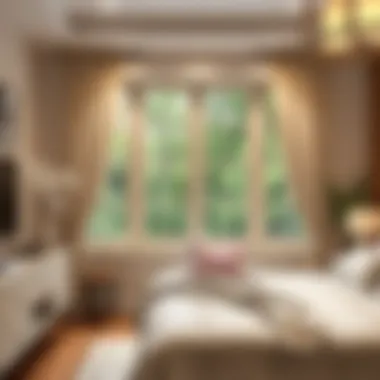
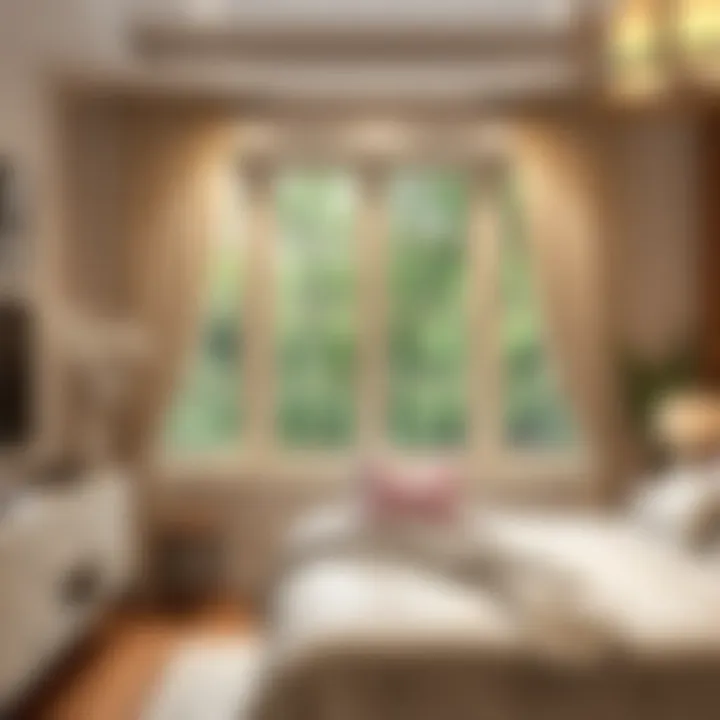
- Width: Measure the window width from the left frame to the right frame.
- Height: Measure from the top of the window frame (or where the rod will be placed if it’s above the window) down to the sill or floor, depending on your style choice.
- Depth: If you're using a mounted rod, consider the depth to ensure the panels can fully cover the window when drawn closed.
You might want to take at least three measurements and use the largest one. Sometimes, walls aren’t perfectly straight, and those few millimeters could lead to an imperfect fit.
Hanging Techniques
Once measurements are squared away, hanging your window panels properly is the next big hurdle. The way you hang your panels dramatically impacts their appearance and function. Here are a few techniques to consider:
- Inside Mount: This method involves attaching the hardware inside the window frame. This approach is sleek and modern, but requires precision in measuring, or you risk gaps that can let light seep in.
- Outside Mount: An outside mount extends beyond the window frame, making your windows look larger and allowing for greater light control. This is also helpful if your walls are uneven.
- Floating Rods: If you're feeling creative, try floating rods which allow the fabric to appear as if it's swaying gently. This technique works beautifully for sheer panels.
Each hanging style has its own set of visual and practical advantages, so pick one that aligns with your room’s vibe and your needs.
Cleaning and Upkeep
The dust bunnies don’t take a holiday, even if your panels do. It’s key to keep your window treatments in tip-top shape to maintain their aesthetic and operational functionality. Cleaning methods can differ significantly based on the material used:
- For fabric panels, a gentle vacuum or a soft brush is usually enough to remove dust. Many fabrics are machine washable; follow the care label for specifics.
- Wooden and faux wood options can be wiped with a damp cloth or dusted lightly with a soft cloth to prevent scratches and keep them looking fresh.
- Metal or vinyl options typically require a simple wipe-down with a suitable cleaner that won't harm the finish.
It’s also a good practice to check the mounting hardware regularly. If screws or brackets seem loose, re-tightening can prevent future hang-ups—literally. Besides, keeping an eye on those edges helps catch frays or other damage before they escalate.
Maintain your panels like you would a fine art collection—keep them clean, keep them protected, and let them shine in their own right. This practice ensures your style sanctuary remains as inviting and serene as the day you installed those beautiful window treatments.
Current Trends in Window Panels
In the realm of interior design, window panels are becoming veritable game changers, influencing not just aesthetics but also how we interact with light and space within our homes. With an increasing focus on creating a personal oasis, understanding current trends in window panels is vital for designers, retailers, homeowners, and DIY enthusiasts alike. These trends not only reflect shifting preferences but also respond to environmental considerations and the need for practicality in living spaces.
Popular Styles and Designs
Today’s window panels come in a smorgasbord of styles, each tailored to bring a unique flair to home interiors. Layered looks have taken front and center, enabling folks to combine various fabrics for depth and texture. Picture a rich, heavy drape paired with light, airy sheers—a strategy that not only plays with opacity but also gives you creative freedom with light control.
Some popular styles include:
- Bohemian: Incorporating colorful patterns and organic shapes, this style encourages homeowners to express individuality through bold choices.
- Minimalist: Clean lines and muted tones characterize this trend. Simple, functional panels in solid colors are favored, allowing a room's architecture to shine.
- Industrial: With a nod to urban chic, this style often employs raw materials and dark colors. Metal accents in the hardware can add an edgy vibe which attracts many contemporary homeowners.
- Traditional or Classic: For those who favor timeless elegance, detailed valances and floral prints remain a steadfast choice. This trend aligns well with historical homes or spaces with vintage flair.
Each style offers its own set of benefits, enhancing not just visual appeal, but also providing functional advantages like thermal insulation and sound absorption, necessary for today's world.
Sustainable Material Choices
As awareness of sustainability grows, it's no surprise that eco-friendly materials are making waves in the window treatment industry. Homeowners increasingly prefer to align their values with their purchasing decisions, which often leads to opting for sustainable materials. Bamboo, organic cotton, and recycled polyester are among the top choices that blend well with the aesthetics and functionality of modern window panels.
- Bamboo: Not only is this material renewable, but it also lends a natural elegance to spaces while offering excellent sun filtering properties.
- Organic Cotton: Free from toxic chemicals, this drop renders a safe option for homes, especially those with children or pets. Its soft texture adds a layer of comfort to any space.
- Recycled Polyester: Cleverly re-purposed, this material utilizes post-consumer plastic, appealing to eco-conscious buyers.
"Going green in design doesn't mean you sacrifice style; it’s about making choices that reflect our priorities while enhancing the home’s aesthetic."
The trend towards sustainability is not just a passing phase, it reflects a fundamental shift in how we approach decorating our homes. As we merge style with responsible selections, these choices become an integral part of our living spaces, offering beauty and conscience in equal measure.
Finale
The conclusion of a discussion about style sanctuary window panels is not just an afterthought. It encapsulates the essence of what has been explored throughout the article, providing a reflective take on the numerous aspects that enhance living spaces. Understanding the significance of window treatments goes beyond aesthetic appeal; it’s about creating a sanctuary where comfort and design meet. By focusing on various elements, the conclusion helps reinforce the practical benefits and design considerations that were highlighted earlier.
Summary of Key Points
Let's revisit some crucial points covered in the article:
- Significance of Window Treatments: They are not merely functional; they serve as vital components of the overall design scheme in a home.
- Diverse Material Choices: The exploration of fabrics, woods, metals, and synthetic materials clarified how each option caters to different styles and environments.
- Installation Insights: Correct measuring and hanging methods ensure that the window panels enhance the space without fuss.
- Trends in Design: Current trends showcase a shift toward sustainability, providing a fresh perspective in the decorative approach.
- Manipulating Natural Light: Window panels are essential in controlling the amount of light that enters your home, impacting mood and ambiance.
These elements work together to have a profound impact on household design, creating spaces that feel coherent and comfortable. By synthesizing these key points, homeowners and designers alike are empowered to make informed choices about window paneling, tailored to their unique needs.
Final Thoughts on Style Sanctuary Window Panels
As we draw our exploration to a close, the importance of carefully chosen style sanctuary window panels becomes apparent. The right panels do more than just beautify a room; they have the potential to transform an entire space. Thoughtful selection processes, covering everything from color and material to the overarching design aesthetic, can lead to a truly harmonious environment. Moreover, as lifestyle preferences continue to evolve, adaptability is key. Whether it's a modern loft in the city or a cozy cottage by the countryside, window panels play a significant role in personalizing spaces.
Choosing panels that reflect one's style, while also being functional, opens up a world of design possibilities. As the article emphasizes, informed decisions lead to better outcomes, ultimately resulting in spaces that don't just look good but feel good too. Therefore, experimenting and investing in quality window treatments is not merely a guideline; it's an invitation to enhance everyday living.
"Style isn’t just what you see; it’s how the space makes you feel."













